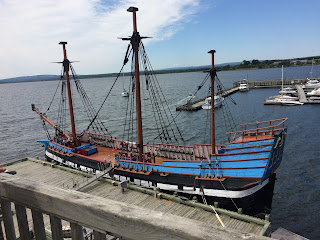On our first short walk exploring this tiny town we saw banners on all the streets with names like MacDonald, Sutherland, Douglas, Cameron. One of our crew perks was free admission to the local history museum, and since I love learning the stories that towns tell about themselves, that was the focus of our day off. (Well, that and the bar...)
 |
| Postcard from the Hector Heritage Quay museum |
The town was settled in the 1770s by the Dutch ship Hector, about half our size but carrying 189 emigrants from the Scottish Highlands after a tough 3-month voyage. The ship was past its prime and better suited for carrying cargo on coastal runs than passengers across the North Atlantic. They were within sight of land on this continent when a strong gale blew them back to sea, costing 2 weeks they couldn't afford. They finally landed in September with insufficient time to prepare for winter. I hadn't realized how desperately poor they were, suffering the double whammy of tough farming conditions at home (short season, bad soil, transitioning from cattle which used land densely and employed many to sheep which had lower profit per head) and in addition what profits they could make were skimmed by a (corrupt) land management system and middle men. The theme was similar to the stories we told of the Spanish settlers on the galleons 2 centuries earlier, though different in the exact details and context. A difficult, dangerous voyage that people willingly undertook -- because that risk was better for their families than staying in Europe would be. Lots of detail about the history of the voyage and the settlement is here. One of my favourite stories about the trip was the story of the bagpiper who couldn't afford to pay his passage; the other emigrants said they would share their rations with him if he would play the songs of home to keep their spirits up on the long voyage. (They did, and he did.) Another story tells how, early in the voyage, people would throw away the "biscuit" (a bread similar to hard tack) that had gone moldy. One frugal gentleman kept these castoffs; and after the ship was blown off course by the storm, was able to help the nearly starving passengers by offering these old crusts back again.
Once I understood the background it didn't take all that long for me to translate "Nova Scotia" to "New Scotland." I saw the heritage everywhere -- in the glorious red hair of the children who came to visit the ship, and the pipes and drums that greeted us.
 |
| Full-size replica of the Hector |
 |
| Imagining the area below decks; bunks 4 deep, and still not enough for everyone. Either they doubled up, or slept in shifts. |





No comments:
Post a Comment